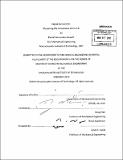| dc.contributor.advisor | Doug Hart. | en_US |
| dc.contributor.author | Hernandez-Stewart, Daniel | en_US |
| dc.contributor.other | Massachusetts Institute of Technology. Dept. of Mechanical Engineering. | en_US |
| dc.date.accessioned | 2010-08-31T14:44:56Z | |
| dc.date.available | 2010-08-31T14:44:56Z | |
| dc.date.copyright | 2010 | en_US |
| dc.date.issued | 2010 | en_US |
| dc.identifier.uri | http://hdl.handle.net/1721.1/57792 | |
| dc.description | Thesis (S.M.)--Massachusetts Institute of Technology, Dept. of Mechanical Engineering, 2010. | en_US |
| dc.description | Cataloged from PDF version of thesis. | en_US |
| dc.description | Includes bibliographical references (p. 101-104). | en_US |
| dc.description.abstract | This paper seeks to resolve the biggest problem with hearing aids, their physical fit. By digitally scanning the ear canal and taking the dynamics of the ear into account the performance and comfort of a hearing aid can be greatly improved. Current optical techniques for 3-D imaging are too expensive to be implemented in the ear canal for the purpose of custom fitted hearing aids. A new absorption based optical technique is introduced, which is capable of generating three dimensional maps of an ear subjected to a varying pressure. Specifically a hearing aid can be constructed with allowances for the compliance of the ear and the distortions associated with jaw movement. It is shown that the information that can be captured with this new technique will be of value toward improving hearing aids, and that the hearing aid industry is ready to take advantage of a digital scanner. A one dimensional calibration was made, and qualitative 3-D data is shown. The imaging technique was implemented with much lower cost equipment then would be needed by other 3-D techniques such as interferometry. A technique for the laboratory manufacture of brushed on fluorescent balloons was presented that are suitable to be used by this imaging technique to measure the dynamics of the ear. The bulk compliance of a human ear in vitro was measured with a laboratory fabricated balloon. | en_US |
| dc.description.statementofresponsibility | by Daniel Hernandez-Stewart. | en_US |
| dc.format.extent | 104 p. | en_US |
| dc.language.iso | eng | en_US |
| dc.publisher | Massachusetts Institute of Technology | en_US |
| dc.rights | M.I.T. theses are protected by
copyright. They may be viewed from this source for any purpose, but
reproduction or distribution in any format is prohibited without written
permission. See provided URL for inquiries about permission. | en_US |
| dc.rights.uri | http://dspace.mit.edu/handle/1721.1/7582 | en_US |
| dc.subject | Mechanical Engineering. | en_US |
| dc.title | Digital ear scanner : measuring the compliance of the ear | en_US |
| dc.type | Thesis | en_US |
| dc.description.degree | S.M. | en_US |
| dc.contributor.department | Massachusetts Institute of Technology. Department of Mechanical Engineering | |
| dc.identifier.oclc | 650310389 | en_US |
